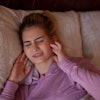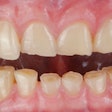Temporomandibular joint (TMJ) replacement surgery may have complications, most often temporary facial nerve damage, in almost 40% of cases. This study was recently published in the Journal of Cranio-Maxillofacial Surgery.
However, more detailed research is needed, as inconsistent data may mean the actual complication rate is lower than currently reported, the authors wrote.
“The meta-analysis reports a moderate prevalence of neurogenic complications and a low prevalence of other complications which shows that it’s a safe procedure,” wrote the authors, led by Dr. Stefan Gerber of the Maxillofacial Surgery Center Vuillemin SA in Switzerland (J Craniomaxillofac Surg, April 21, 2025).
For this study, 35 relevant clinical studies were included for review. Included studies involved at least 10 adults who underwent total alloplastic TMJ replacement using a prosthesis with both fossa and mandibular components.
The publications spanned from 2013 to 2023, with an average of 36 patients per study and 56 prostheses installed. A random-effects meta-analysis of proportions was used to synthesize complication rates across the studies, they wrote.
Complications occurred in 38.9% of cases (95% confidence interval [CI]: 27.4 to 51.0%, I² = 72%). Transient facial nerve palsy was the most common complication, occurring in 24.1% of cases (95% CI: 15.9 to 33.3%, I² = 82%). Sensory changes were reported in five and seven studies, with a prevalence of 3.3% (95% CI: 0.8 to 6.8%, I² = 0%) for transient and 17.4% (95% CI: 0.6 to 45.7%, I² = 95%) for permanent numbness.
Furthermore, persistent postoperative pain was reported in nine studies, with a prevalence of 11.5% (95% CI: 5.4 to 19.4%, I² = 78%) and was lower in studies with under 36 months of follow-up (9.4%; 95% CI: 1.5 to 21.7%, I² = 70%) compared to those with three or more years (13.2%; 95% CI: 4.4 to 25.2%, I² = 85%). Heterotopic bone formation occurred in 4.3% of cases (95% CI: 0 to 13.5%, I² = 91%), they wrote.
Less frequent complications included prosthesis dislocation (2.4%; 95% CI: 0.7 to 4.8%, I² = 8%), bleeding or hematoma (2.4%; 95% CI: 0.4 to 5.3%, I² = 0%), and infection (1.8%; 95% CI: 0.4 to 3.7%, I² = 56%). Rare complications were prosthesis removal (1.5%; 95% CI: 0.5 to 2.8%, I² = 62%), malocclusion (1%; 95% CI: 0 to 3.3%, I² = 28%), and hardware failure (0.1%; 95% CI: 0 to 1.6%, I² = 64%).
The study had limitations. The inconsistent reporting of absent complications may have resulted in an overestimation of complication rates, the authors added.
“Future studies should report the various complications in more detail and in full in order to draw further conclusions about possible improvements in TMJ replacement surgery in terms of patient welfare,” they concluded.




















